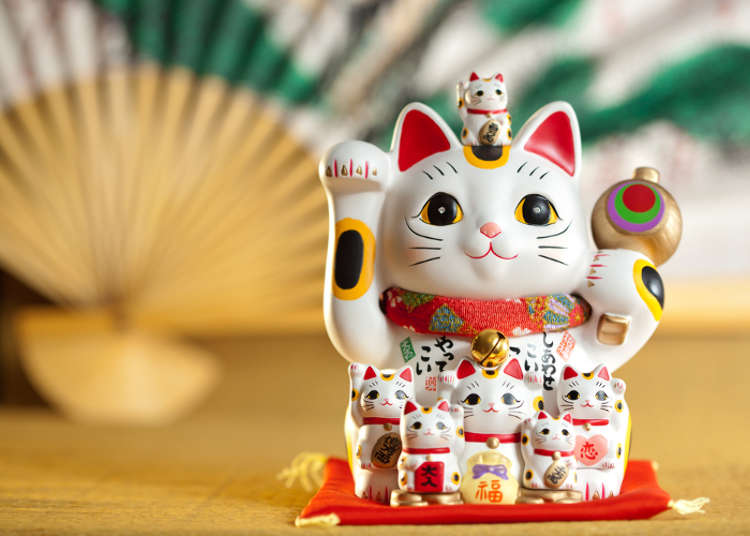
Have you ever encountered a maneki neko? In English, these are also commonly referred to as 'lucky cats' due to their use as a kind of talisman, or lucky charm. These whimsical cat figures have become one of Japan's most recognizable symbols. The name 'mankei neko' can be attributed to the cat's welcoming paw, as the literal translation is 'beckoning cat.'

Lucky cats are most often ceramic, however, you may find them made from any number of materials–from wood or plastic, to luxury lucky cats made from jade or gold. Even in modern times, maneki neko are still prevalent in Japan. It’s not uncommon to see the statues in shrines, or as decoration. You also may find their slow-waving, mechanical paws welcoming you to restaurants, pachinko parlors, and other businesses across the country.
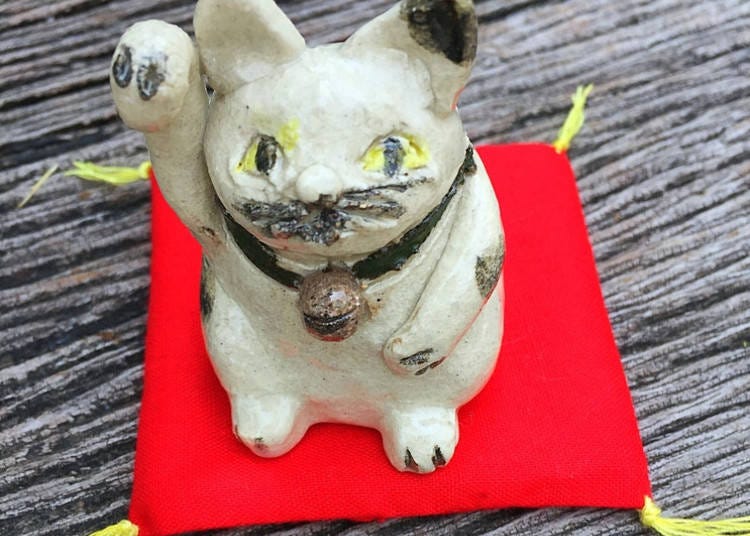
When trying to pinpoint the exact origin of the maneki neko, the only thing that can be concluded is that its birthplace is uncertain. There is debate as to whether the cats were originally created in Tokyo or in Osaka, although it is generally agreed upon that they were first seen sometime in the late Edo Period. The uncertainty regarding maneki neko's history has led to quite a few different legends explaining its beginnings.
The Accessories Make the Lucky Cat
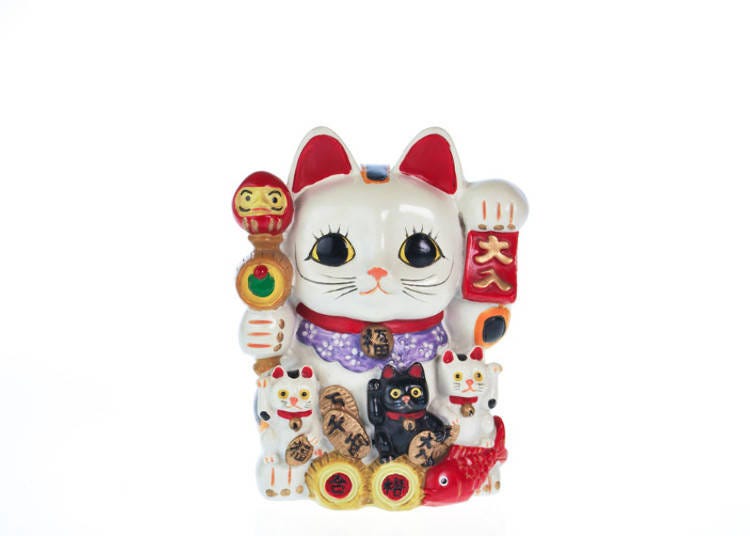
If you look closely at various maneki neko, you'll notice certain items that are frequently held or worn by the cats.
・Neck decorations: You'll rarely see a lucky cat with an unadorned neck. Collars, decorative bibs, and bells are all common neck ornaments for maneki neko. Like today, the real pet cats of the Edo Period wore collars with bells to allow their whereabouts to be easily tracked. As for the bibs, it has been speculated that they are related to those worn by Buddhist jizo statues.
・Coins: Maneki neko often hold a koban, a gold coin that was used in the Edo Period. A koban was worth one ryo (roughly $1,000 USD by today's standards), Japan's monetary unit of the era. You may even see a cat holding a coin marked 千万両 which is ten million ryo, an incredible amount of money, especially for that time period!
・A carp (koi), or other fish: This is thought to be a symbol of fortune and abundance.
・Money Bag: This symbolizes luck, along with wealth.
・Marble or Gemstone: One of these in the paws of a lucky cat symbolizes wisdom, as well as wealth.
・Fan or Drum: Both of these objects represent luck with business. The drum specifically, is a symbol of a shop that is overflowing with customers.
・Hollowed Gourds (hyotan): These were as containers for sake and over beverages, often used by another of the Seven Lucky Gods, Fukurokuju, the god of wisdom and longevity. It is believed to ward off evil and bring good luck.
While these are some of the most common lucky charms you might find on a maneki neko, there are plenty of other objects that have been associated with them as well.
Making a Statement Without Making a Sound
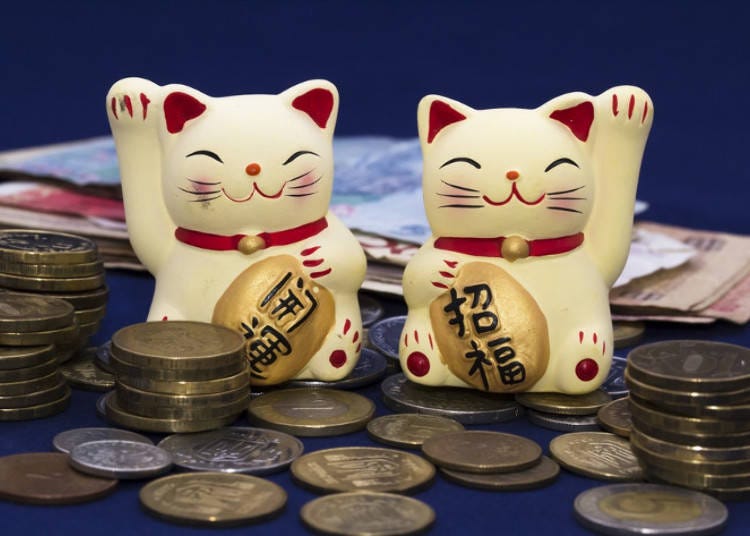
You can tell a lot about a maneki neko by examining its gestures, and one of its defining characteristics is its raised paw. You can see lucky cats raising the left paw, right paw, or occasionally, both. The positioning of the paws is more than just an artistic choice. There is a distinct meaning and belief behind each gesture, although the those may differ depending on who is asked. Generally speaking, the the lucky cat gestures are as follows:
・Right paw raised: Brings wealth and good luck
・Left paw raised: Attracts customers to a place of business
・Both paws raised: Provides protection
The higher the paw is raised, the more luck the cat is said to invite!
Colorful Kitties - Maneki Neko and their Various Colors
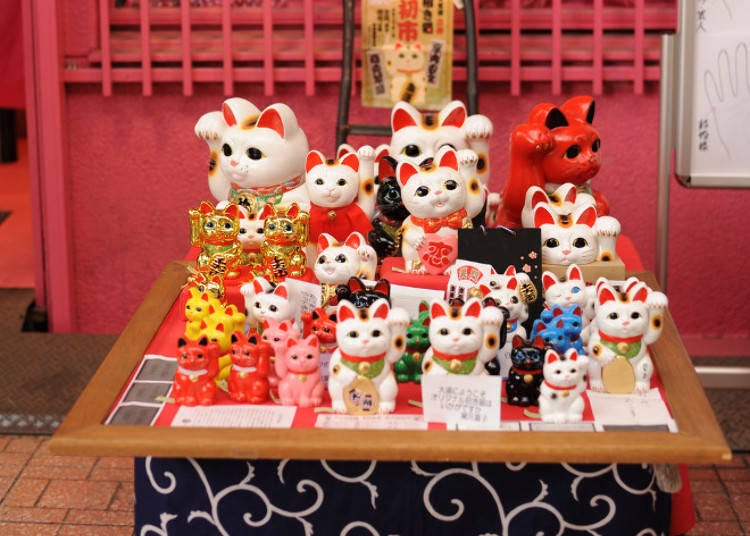
While most often seen in the original Calico form, maneki neko are also available in a rainbow of different colors. As with gesture and ornamental variations, these too are symbolic, with each color associated with a different form of luck. The following color attributes are said to be as follows:
・White: Positivity and purity
・Black: Protection against evil
・Gold: Wealth and prosperity
・Red: Marriage, love, and other personal matters
・Green: Education and health
・Blue: Intelligence, wisdom, and success
・Pink: Love and romance
・Yellow: Stability, health, and relationships
Based upon all of the aforementioned variations, you can choose the lucky cat that is best for you!
Maneki Neko - From Japan to Across the World
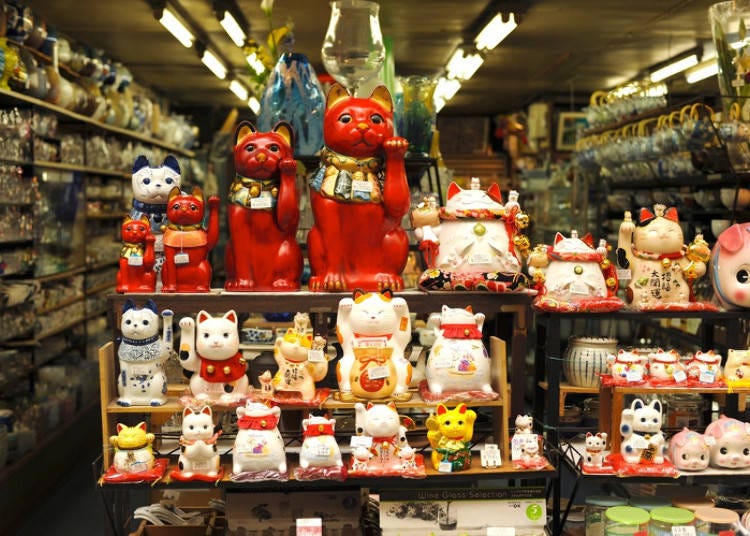
Maneki neko have also appeared in various forms in pop culture. The cats have been found in literature, anime, and even video games. These cats have become ubiquitous, popping up in just about every continent. Maneki neko have become a favorite among fans of Japanese culture, as well as those with an interest in good luck charms. They can be found in nestled among the trinkets in Asian specialty shops, or as decorations at Japanese Festivals across the world.
- Area
- Category
*Prices and options mentioned are subject to change.
*Unless stated otherwise, all prices include tax.
Popular Tours & Activitiess
-

How to Get Don Quijote's Exclusive 2025-2026 Winter Gift (+Tax-Free Savings)
-

Tokyo City Pass Upgrade: Harry Potter Studio Tour & Top Sights up to 85% Off
by: Guest Contributor
-
Ad

Preserving the Beauty of World Heritage Site Shirakawa-go for the Future Through Responsible Travel
-

[Extended Offer!](12% OFF KKday Coupon) Mt. Fuji Autumn Leaves, Powder Snow & More! 15 Best Tours to Experience Japan in Fall & Winter
-

Strawberries, Style, and Tokyo’s Coolest Neighborhood: Winter Afternoon Tea in Kichijoji
by: Guest Contributor
-

The Best Japanese Food Representing 2025! 'Dish of the Year®' Annual Award Results Announced
Inspiration for Accommodations
-

Enjoy Mt. Fuji from the Comfort of Your Room! Recommended Ryokan with Mt. Fuji View
-

Stay Near the Cherry Blossoms! Hotels for Cherry Blossom Viewing in Tokyo
-

Family-Friendly Hotels with Free Shuttle to Disneyland: Convenient Access for a Magical Stay
-

Top Ranked Hakone Hotels with Mt. Fuji View: Enjoy Stunning Scenery from Your Private Space
-

Convenient Tokyo Hotels with Airport Shuttle: Ideal for Families and Heavy Luggage
-

Stunning Tokyo Tower View Hotels: Enjoy Spectacular Scenery from Your Private Space
-

Convenient Asakusa Hotels with Kitchens: Ideal for Extended Family Visits
-

Experience Luxury: Hakone's 10 Best Five-Star Accommodations
-

Enjoy Mt. Fuji Autumn Leaves! Top Hotels Near the Popular Autumn Leaves Corridor
-

Experience Hakone Fall Foliage from Your Room with Stunning Views
-

Exploring Tokyo Station: 11 Must-Visit Spots Around the Heart of Tokyo
-

16 Secrets About Mt. Fuji, the Symbol of Japan: Even Japanese People Don’t Know That?!
-

Learn the Art of Flower Arrangement at Ohara School of Ikebana
by: Holly Neslusan
-

Tokyo Tsukiji|Tsukiji Area Map & Sightseeing Information
-

What to Pack for Japan: 8 Essential Things for a Hassle-Free Trip
-

[MOVIE] Folding Fun at the International Origami Center
by: Holly Neslusan
- #best ramen tokyo
- #what to buy in ameyoko
- #what to bring to japan
- #new years in tokyo
- #best izakaya shinjuku
- #things to do tokyo
- #japanese nail trends
- #what to do in odaiba
- #onsen tattoo friendly tokyo
- #daiso
- #best sushi ginza
- #japanese convenience store snacks
- #best yakiniku shibuya
- #japanese fashion culture
- #best japanese soft drinks


















